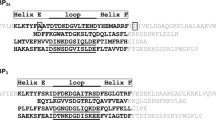Abstract
Calcium-binding proteins of the EF-hand family are widely distributed in the vertebrate central nervous system. In the present study of the trout brain, immunocytochemistry with a monoclonal antibody against chick gut calbindin-28k and a polyclonal antibody against bovine S100 protein specifically stained ependymocytes and radial glia cells with identical patterns. Western blot analysis of trout brain extracts with the antibodies to S100 and calbindin stained the same low-molecular-weight (10 kDa) protein band. In rat brain extracts, however, the monoclonal antibody to calbindin recognized a major protein band with molecular weight corresponding to that of calbindin-28k. This indicates that the trout protein is a new calcium-binding-like (calbindin-like) molecule that is immunologically related to both S100 and calbindin. Immunocytochemical studies of the trout brain using the antibodies to CaB and S100 showed that ependymocytes were stained in most ventricular regions, except in a few specialized ependymal areas of the ventral telencephalon, epithalamus, hypothalamus (including the paraventricular organ and saccus vasculosus) and brain stem. Immunocytochemistry also indicated the presence of calbindin-like protein in radial glia cells of several regions of the brain (thalamus, pretectal region, optic tectum, and rhombencephalon). Differences in immunoreactivity between neighbouring ependymal areas suggest that this protein may be a useful marker of different territories. All immunoreactive glial cells were nicotin-adenin-dinucleotide-phosphate diaphorase-positive, although this enzymohistochemical reaction is not specific for these glial cells since it reveals oligodendrocytes and some neurons. Immunoreactivity appears at different developmental stages in the different brain regions, with a broadly caudorostral gradient, suggesting that the expression of this protein is developmentally regulated. Comparison of the distribution of the calbindin-like protein with that of glial acidic fibrillary protein indicates that calbindin-like immunocytochemistry is a specific technique for revealing radial glia and ependymocytes in the trout.
Similar content being viewed by others
Author information
Authors and Affiliations
Additional information
Accepted: 20 June 1997
Rights and permissions
About this article
Cite this article
Manso, M., Becerra, M., Becerra, M. et al. Expression of a low-molecular-weight (10 kDa) calcium binding protein in glial cells of the brain of the trout (Teleostei). Anat Embryol 196, 403–416 (1997). https://doi.org/10.1007/s004290050108
Issue Date:
DOI: https://doi.org/10.1007/s004290050108



